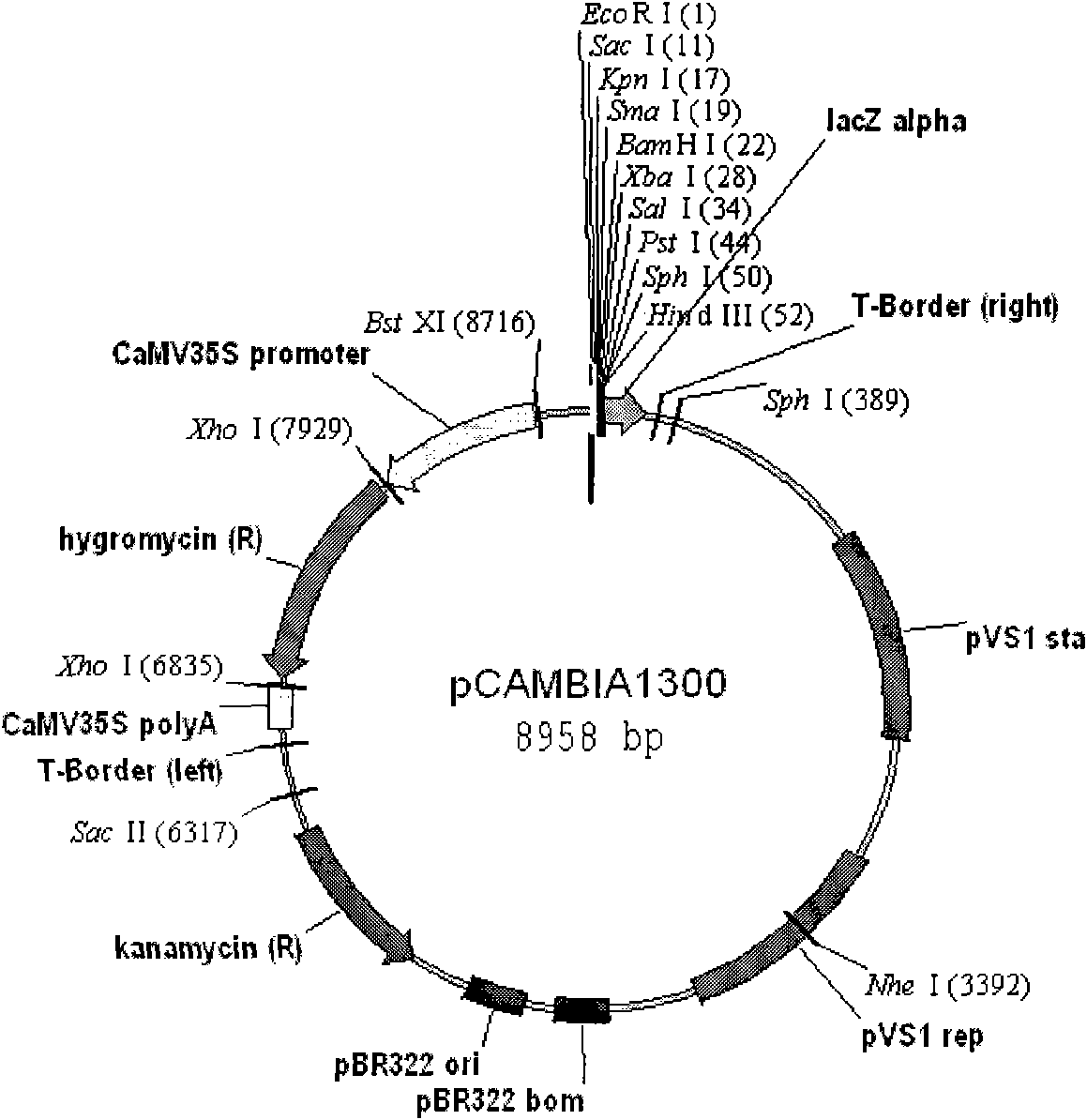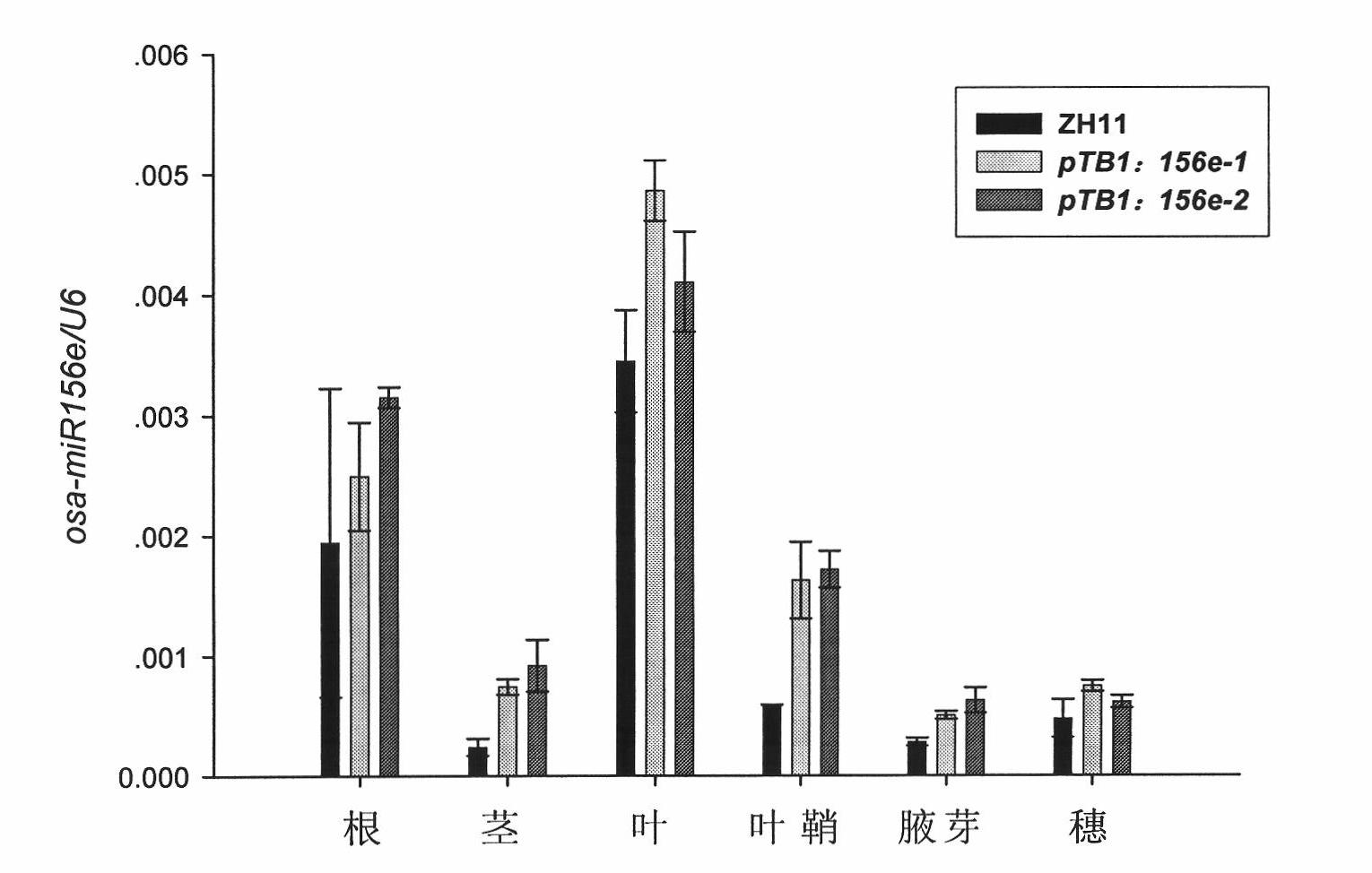Method for controlling plant type of rice
A rice plant type and purpose technology, applied in the field of plant genetic engineering, can solve the problem of rice tiller number decline and other issues
- Summary
- Abstract
- Description
- Claims
- Application Information
AI Technical Summary
Problems solved by technology
Method used
Image
Examples
Embodiment 1
[0031] Example 1. Construction of the rice gene OsTB1 promoter-driven vector pTB1:156e of the osa-miR156e gene
[0032] The constitutive expression of miR156 has an important impact on rice plant architecture: the number of tillers increases greatly, the plants become shorter, the heading becomes later, the panicles become smaller, etc., the seed setting rate decreases, and the yield decreases. The invention drives the expression of miR156 in lateral meristems and other parts through a specific expression promoter, hoping to improve rice tillering ability without affecting other traits, achieve the purpose of improving plant type, and then apply it to rice breeding practice.
[0033] The promoter of the specific expression gene OsTB1 used is mainly expressed in the axillary buds, and also expressed at the base of the top growth point of the stem, the vascular tissue of the stem pith and the vascular tissue of the leaf junction.
[0034] The rice osa-miR156 gene family has 12 m...
Embodiment 2
[0069] Example 2. Genetic transformation and expression of the osa-miR156e gene under the regulation of the OsTB1 promoter
[0070] The pTB1:156e vector was introduced into the rice variety "Zhonghua 11" using the genetic transformation method mediated by Agrobacterium EHA105 (Wu et al., Development of enhancer trap lines forfunctional analysis of the rice genome. Plant J, 2003, 35: 418-427) superior.
[0071] 1) Callus induction
[0072] (1) Ripe rice seeds are dehulled, then treated with 70% ethanol for 1 minute, and 0.15% mercuric chloride for 15 minutes;
[0073] (2) Wash the seeds with sterilized water 4-5 times;
[0074] (3) seeds are placed on the induction medium;
[0075] (4) Culture in a dark place for 5 weeks at a temperature of 25-27°C.
[0076] 2) Callus subculture
[0077] Select bright yellow, compact and relatively dry embryogenic calli, and place them on the subculture medium for 2 weeks in the dark at a temperature of 25-27°C.
[0078] 3) Pre-culture
[...
Embodiment 3
[0104] Example 3. Improvement and application of rice plants transfected with pTB1:156e to plant type
[0105] Among all the transgenic plants transgenic for pTB1:156e, one T0 generation with the best phenotype was selected and planted as a single plant for the next generation. The agronomic traits such as tiller number and yield of a single plant were investigated under different planting densities ( Figure 4 ).
[0106] Planting Design:
[0107] Planting material: select a single-copy line, control species ZH11 and constitutively overexpressed osa-miR156e plant planting density 3 kinds:
[0108] (1) Thin planting: 8 inches x 8 inches (26.7cm x 26.7cm)
[0109] (2) Normal density: 5 inches x 8 inches (16.7cm x 26.7cm)
[0110] (3) Close planting: 5 inches x 5 inches (16.7cm x 16.7cm)
[0111] Each plot: plant 3-5 rows, 10 plants in each row. 2 trials were repeated. Seed test: Take the 3rd to 7th plants in the middle row of the plot, and take 5 plants in a row.
[011...
PUM
 Login to View More
Login to View More Abstract
Description
Claims
Application Information
 Login to View More
Login to View More - R&D
- Intellectual Property
- Life Sciences
- Materials
- Tech Scout
- Unparalleled Data Quality
- Higher Quality Content
- 60% Fewer Hallucinations
Browse by: Latest US Patents, China's latest patents, Technical Efficacy Thesaurus, Application Domain, Technology Topic, Popular Technical Reports.
© 2025 PatSnap. All rights reserved.Legal|Privacy policy|Modern Slavery Act Transparency Statement|Sitemap|About US| Contact US: help@patsnap.com



